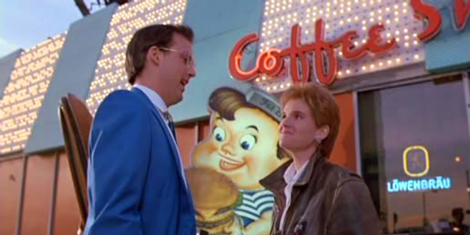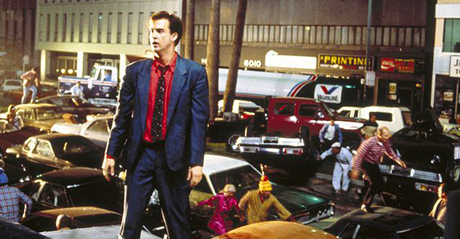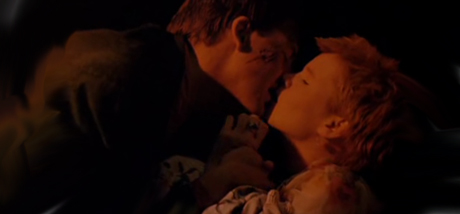|
|
Reviewed by Glenn Erickson
Back in the 1980s, magazine articles bandied about the titles of notoriously respected but un-filmed scripts. The granddaddy of these, much promoted and quoted by our UCLA instructor-screenwriter William Froug, was Walter Newman's Harrow Alley. Out of a longish list, I only remember John Sayles' Eight Men Out and Steve De Jarnatt's Miracle Mile. Both of those filmmakers were lucky in that each was able to, ah, I believe the phrase is, 'fully realize their vision.' In this case, there was a worthwhile vision to be realized.

Released early in 1989, Miracle Mile was almost canceled out by history. The Berlin Wall came down later in the year, giving an elated world the hope that the Cold War nuclear standoff would finally be over. I told my kids, who ranged from four to ten, that a curse was lifting, that had hung over the world for nearly fifty years. Other curses would soon rush in to fill the gap, but it was an optimistic time. Had it been held up for just one year, I think De Jarnatt's show would have been deemed obsolete. But in 1989 we were still living under the axe. We had sat around our Trinitron 'glowing Sony' TVs earlier in the decade, watching some grim PBS special or another, and imagined being visited by scenarios from Peter Watkins' The War Game. With Reagan provoking the Russians every week, I feared for my children. Seven miles from downtown Los Angeles, we'd either be vaporized, or hit by a blast that would blow us all halfway to the beach.
The movie Miracle Mile turned out to be a last beer call for that particular gnawing fear. Past nuclear attack movies had been outright exploitation hysteria (Invasion, U.S.A.), sci-fi fantasies (The Day the World Ended, bleeding heart allegories (The World The Flesh and The Devil), bleak soap operas (On the Beach, Testament), vigilante survivalist tales (Panic in Year Zero!), and eventually Post-Apocalyptic thrillers (The Road Warrior). De Jarnatt's script is an apocalypse in a teacup, a personal nightmare that begins with an unexpected phone call, and ends with Los Angeles becoming a nuclear oven. The Kafka-like nightmare lasts approximately 75 minutes, in real time -- from the middle of the night until dawn.

Let me give De Jarnatt's story a launch-synopsis: Jazz trombonist Harry Washello (Anthony Edwards, with hair) meets Julie Peters (Mare Winningham, cute as a button) in Park La Brea, where she lives with her mother Lucy (Lou Hancock) and sees her father Ivan (John Agar, old but chipper), who lives separately but in the same complex. Ivan and Julie attend Harry's concert in Gardner Park, just to the North. 1 Julie is a waitress at Johnie's Coffee Shop, at the corner of Fairfax and Wilshire, across the street from The May Company and catty-corner from the clothing store Ohrbach's. Falling in love in just the one afternoon, Julie goes to work while Harry gets his sleep; they plan to meet when her work shift ends after midnight. But a power outage causes Harry to oversleep. He rushes to Johnies, to discover that Julie's gone home in tears. He's figuring out his next move when the payphone outside the café rings. Harry listens to a phone call meant for Orange County -- from a guy in a missile silo in the Midwest, phoning home to tell his father that a nuclear war has begun. The Russian retaliation will arrive in just seventy minutes or so. When Harry relates this info to the night crawlers inside the café stockbroker
 Landa (Denise Crosby) believes him, and arranges for an instant escape via helicopter to LAX, and from there on a chartered jet to Antarctica. They'll be leaving from the helipad atop a skyscraper, one block to the East. Now all Harry has to do is round up Julie -- but a crazy series of events detour him away from his mission. Julie took a heavy sleeping pill and can't be roused. By the time they can start for the helipad, the word has spread and Wilshire Blvd. has erupted into total chaos.
Landa (Denise Crosby) believes him, and arranges for an instant escape via helicopter to LAX, and from there on a chartered jet to Antarctica. They'll be leaving from the helipad atop a skyscraper, one block to the East. Now all Harry has to do is round up Julie -- but a crazy series of events detour him away from his mission. Julie took a heavy sleeping pill and can't be roused. By the time they can start for the helipad, the word has spread and Wilshire Blvd. has erupted into total chaos.
All of us, well at least the morbid-minded among us, have thought about what we'd do if we learned that the missiles were due in an hour, Miracle Mile brings the fantasy to full fruition. Harry has a chance to escape, but he'll be tripped up by the same urban nightmare that dogged the plans of Griffin Dunne in After Hours and Bill Murray & Geena Davis in Quick Change: when the crunch is on, just crossing the street can be too much to ask.
I was so location-specific above because Miracle Mile makes a lot of its exact setting in Los Angeles, just down the street from the Los Angeles County Museum of Art. The May Company building has been absorbed into the museum and Orbach's long ago became the Petersen Automotive Museum. But Johnie's is still there, no longer functioning but miraculously evading the wrecking ball. It was threatened for a few days earlier this year, and I rushed down and took some photos. That skyscraper is no longer a lone tower on palm tree-lined Wilshire. I have ridden in its elevator, just once. It is indeed like a ride to outer space, with the floor numbers idling by as one rises.

Writer-director De Jarnatt centers his clever tale in a one-act situation in Johnie's, with a cross section of patrons: a drunk, a pair of garbage collectors, Denise Crosby's antiseptic executive, and a sarcastic transvestite (Danny De La Paz). The great Robert DoQui (RoboCop) is the impatient cook, and clueless O-Lan Jones (Mars Attacks!) is the waitress. Even when the dialogue gets goofy, it all works -- the pitch of agitation grows with each passing minute. Poor Harry rushes about in a panic, detoured by crazy crimes and a police pursuit that stalls on a freeway overpass and sends a S.W.A.T Team after himself and an accidental comrade (Mikelti Williamson), into the wrecked Ohrbach's.
As the sun threatens to rise, Miracle Mile suddenly shows amazing production accomplishments. A master shot of the S.W.A.T. Team making a hasty retreat is an emblematic image -- three years later during the L.A. Riots the L.A.P.D. all but abandoned this part of the city to roving thieves and looters. The film's riot scenes build to a crazy pitch. Although a matte shot helps out for one angle, the show blocked off all of Wilshire Blvd, jammed it with cars and panicked citizens, all to stage four or five minutes of the best panic-chaos seen in End of the World movies. This is what John Sturges wanted for his The Satan Bug, but that United Artists wouldn't pay for. People crawl under cars and fires break out amid a shooting spree. Peeking at TV monitors in a store window. Harry sees an early morning news crew abandon its set, and a remote reporter is shot while trying to cover the panic elsewhere. Armed with a gun, Harry must go on a last-minute search. He finds his helicopter pilot in a gym, a gay guy who insists on first rounding up his boyfriend. How many people has Landa tipped off, and what will happen when there's not enough room in the helicopter? And that's assuming that the helicopter even comes.

De Jarnatt works his visual themes into the movie with such finesse that we don't reach for the anti-pretension alarm. The La Brea Tar Pits, just down the street, is a site for Harry and Julie to meet cute. That part of the park is surrounded by giant palm trees, which become a major symbol. Harry's alarm clock malfunctions because a bird carries a lit cigarette to its nest, starting a fire that knocks out the power to his building. It's sort of an apocalypse-in-miniature that causes Harry to miss his date but catch the terrifying phone call from the missile silo. The burning nest has a visual bookend in a view of a palm tree on fire, as seen past a giant mastodon statue in the middle of the Tar Pits. It's like, poetic, dude: the Pits recorded an earlier extinction, and will perform the same function now. All of Los Angeles has gazed at the oil burbling up in the pit, but ignored the lesson that we're perfectly capable of being wiped out just like those prehistoric hairy Heffalumps and sabertoothed Tiggers. Harry's last speech, delivered in near-blackness, offers a verbal image of he and Julie transformed into diamonds.

I realize that Miracle Mile is not exactly a cheapie, but it looks as if twice its budget is up on the screen. Unlike Jim Cameron's The Abyss from the same year, we aren't expecting a finale nearly as elaborate as what we get. De Jarnatt keeps our mind on Harry's crazy effort to get everybody up to the heliport in time. He at first must haul the semi-conscious Julie around in a shopping cart. Angles on the skyscraper keep reminding us of the possibility of escape. But can't we expect Los Angeles to be targeted with so many H-Bombs that escape will be fruitless? What real chance have they got?
Liking Miracle Mile will to a degree be dependent on buying into De Jarnatt's fantasy, a visualization of one paranoid scenario in a million. The earnest performances are appropriate to the circumstances, I think. The show is too personal to be alarmist but also too smart to preach. And I know perfectly sane folk who insist that the nuclear standoff, post- Cuban missile crisis, wasn't the hair-trigger situation presented by the media. Well, maybe. For this maybe-paranoid fantasy, Steve De Jarnatt gets the pot boiling faster and hotter than anybody. Heck if our power and cell phones in Los Angeles went out at the same time, the chaos of Miracle Mile might happen like spontaneous combustion. A nuclear attack would be entirely optional.

The KL Studio Classics Blu-ray of Miracle Mile is a dazzling encoding that wipes out memories of weak transfers on earlier laserdiscs and DVDs. The HD image brings out some great -- and very '80s -- art design. De Jarnatt's graphic novel-like shots look great in the widescreen aspect ratio. Director of Photography Theo van de Sande really pulls the film's style together. Tangerine Dream's music is another inspired choice -- they keep showing up on Savant favorites with their scores that transcend other synthesized music of the 1980s.
Kino clearly reached out to De Jarnatt and reaped a bounty of extras that will please the film's many fans. The director participates in two commentaries, one on his own with writer Walter Chaw and one with Van de Sande and production designer Chris Horner. Another extra empties out the director's keepsake box, giving us a sort of gag reel with deleted scenes and bloopers. New featurettes gather the 'Johnie's café gang for a look back at their ensemble play-within-a-play, while Anthony Andrews and Mare Winningham appear in a separate, mutually affectionate interview. An animated 'alternate diamond' ending turns out to be a wise candidate for excision. A trailer is included, along with another for De Jarnatt's other sci-fi offering, Cherry 2000.
And let me praise Kino's classy cover artwork -- this picture deserves it.

On a scale of Excellent, Good, Fair, and Poor,
Miracle Mile Blu-ray rates:
Movie: Excellent
Video: Excellent
Sound: Excellent
Supplements:
Deaf and Hearing Impaired Friendly?
YES; Subtitles: English
N0; Subtitles: None
Packaging: Keep case
Reviewed: July 4, 2015
Footnotes:
1. Early on, during the jazz concert scene, we see Gardner Park, which was built via a massive excavation in the 1980s. Up the 'hill' out of the pit we can see the original Pan-Pacific Auditorium, not long before it was torn down. All the art deco masts are still up. It isn't obvious, but the place had been a wreck for years, boarded up and ready to crumble.
The Pan-Pacific had been an all-purpose venue. In the 1940s it was a ballroom and an ice skating arena, which is how it is presented in Frank Tuttle's solid film noir Suspense. In his autobiography, Walter Mirisch says that Elvis Presley performed there as well. A much smaller building with one feeble mast is there now, visible from Beverly Boulevard.
Return

Text © Copyright 2015 Glenn Erickson
See more exclusive reviews on the Savant Main Page.
Reviews on the Savant main site have additional credits information and are often updated and annotated with reader input and graphics.
T'was Ever Thus.
Return to Top of Page
|

